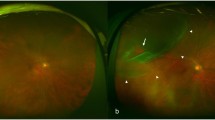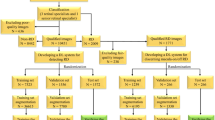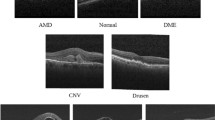Abstract
Retinal detachment (RD) is a severe condition that causes decreased visual acuity and blindness if left untreated timely. The early screening and identification of retinal detachment can ameliorate the successful rate of visible results and RD. The manual screening of retinal detachment is a labor-intensive and time-consuming task. This paper is concerned with pre-trained deep learning networks for feature extraction and classification. Deep learning models need large amounts of training data since they involve many parameters. This is a severe problem in medical informatics where the amount of data available is very low, and ground truth data is a small fraction of the same. The domain of Retinal Detachment (RD) is no different. Typical public domain databases related to RD typically have a few hundred images, leading to fitting issues for deep learning models. This work investigates the role of transfer learning for feature extraction and classification of RD and Non-RD color fundus images. We have also analyzed the performance of different deep neural networks through fundus imaging to detect (RD) eyes and Non-RD eyes. The deep convolutional networks such as AlexNet, InceptionV3, GoogleNet, VGG19, DenseNet, and ResNet50 were trained and tested on publically available datasets of RD and Non-RD fundus images. A ResNet50 framework through transfer learning shows the best classification performance in terms of Accuracy, Sensitivity, Specificity, Precision, and F1 score values of 99.50%, 99.00%, 99.99%, 99.99%, and 99.49%, respectively, and best for detecting RD and Non-RD fundus images compared to other learning models. This study inferred the promising results for a diagnostic system for retinal detachment with relatively high sensitivity and specificity.
Access this article
We’re sorry, something doesn't seem to be working properly.
Please try refreshing the page. If that doesn't work, please contact support so we can address the problem.








Similar content being viewed by others
References
Wei W 2019 Atlas of Retinal Detachment: Diagnosis and Differential Diagnosis. Springer
Miki D, Hida T, Hotta K, Shinoda K and Hirakata A 2001 Comparison of scleral buckling and vitrectomy for retinal detachment resulting from flap tears in superior quadrants. Jpn. J. Ophthalmol. 45(2): 187–191
Heussen N, Feltgen N, Walter P, Hoerauf H, Hilgers R D and Heimann H 2011 Scleral buckling versus primary vitrectomy in rhegmatogenous retinal detachment study (SPR Study): predictive factors for functional outcome. Study report no. 6. Graefe’s Arch. Clin. Exp. Ophthalmol. 249(8): 1129–1136
Rowe J A, Erie J C, Baratz K H, Hodge D O, Gray D T, Butterfield L and Robertson D M 1999 Retinal detachment in Olmsted county, Minnesota, 1976 through 1995. Ophthalmology 106(1): 154–159
Mitry D, Charteris D G, Yorston D, Siddiqui M R, Campbell H, Murphy A L, Fleck B W, Wright A F, Singh J and Scottish RD Study Group 2010 The epidemiology and socioeconomic associations of retinal detachment in Scotland: a two-year prospective population-based study. Investig. Ophthalmol. Vis. Sci. 51(10): 4963–4968
Van de Put M A J, Hooymans J M, Los L I and Dutch Rhegmatogenous Retinal Detachment Study Group 2013 The incidence of rhegmatogenous retinal detachment in The Netherlands. Ophthalmology 120(3): 616–622
Hajari J N, Bjerrum S S, Christensen U, Kiilgaard J F, Bek T and La Cour M 2014 A nationwide study on the incidence of rhegmatogenous retinal detachment in Denmark, with emphasis on the risk of the fellow eye. Retina 34(8): 1658–1665
Li X 2003 Beijing Rhegmatogenous Retinal Detachment Study Group: Incidence and epidemiological characteristics of rhegmatogenous retinal detachment in Beijing, China. Ophthalmology 110: 2413–2417
Zou H, Zhang X, Xu X, Wang X, Liu K and Ho P C P 2002 Epidemiology survey of rhegmatogenous retinal detachment in Beixinjing District, Shanghai, China. Retina 22(3): 294–299
Wong T Y, Tielsch J M and Schein O D 1999 Racial difference in the incidence of retinal detachment in Singapore. Arch. Ophthalmol. 117(3): 379–383
Chen S N, Lian I B and Wei Y J 2016 Epidemiology and clinical characteristics of rhegmatogenous retinal detachment in Taiwan. Br. J. Ophthalmol. 100(9): 1216–1220
Park S J, Choi N K, Park K H and Woo S J 2013 Five year nationwide incidence of rhegmatogenous retinal detachment requiring surgery in Korea. PLoS one 8(11): e80174
Ikeda T, Fujikado T, Tano Y, Tsujikawa K, Koizumi K, Sawa H, Yasuhara T, Maeda K and Kinoshita S 1999 Vitrectomy for rhegmatogenous or tractional retinal detachment with familial exudative vitreoretinopathy. Ophthalmology 106(6): 1081–1085
Sokol J T, Schechet S A, Rosen D T, Ferenchak K, Dawood S and Skondra D 2019 Outcomes of vitrectomy for diabetic tractional retinal detachment in Chicago’s county health system. PLoS One 14(8): e0220726
Amer R, Nalci H and Yalcindag N 2017 Exudative retinal detachment. Surv. Ophthalmol. 62(6): 723–769
Byer N E 2001 Subclinical retinal detachment resulting from asymptomatic retinal breaks: prognosis for progression and regression. Ophthalmology 108(8): 1499–1503
Eijk E S, Busschbach J J, Timman R, Monteban H C, Vissers J M and van Meurs J C 2016 What made you wait so long? Delays in presentation of retinal detachment: knowledge is related to an attached macula. Acta Ophthalmologica 94(5): 434–440
Soliman A Z, Silva P S, Aiello L P and Sun J K 2012 Ultra-wide field retinal imaging in detection, classification, and management of diabetic retinopathy. In: Seminars in Ophthalmology, Vol. 27, No. 5–6, pp. 221–227. Taylor & Francis
Silva P S, Horton M B, Clary D, Lewis D G, Sun J K, Cavallerano J D and Aiello L P 2016 Identification of diabetic retinopathy and ungradable image rate with ultra wide field imaging in a national tele ophthalmology program. Ophthalmology 123(6): 1360–1367
Gulshan V, Peng L, Coram M, Stumpe M C, Wu D, Narayanaswamy A, Venugopalan S, Widner K, Madams T, Cuadros J and Kim R 2016 Development and validation of a deep learning algorithm for detection of diabetic retinopathy in retinal fundus photographs. Jama 316(22): 2402–2410
He J, Baxter S L, Xu J, Xu J, Zhou X and Zhang K 2019 The practical implementation of artificial intelligence technologies in medicine. Nature Medicine 25(1): 30–36
Model Zoo—Deep learning code and pre-trained models for transfer learning, Education purposes and more—https://modelzoo.co/
Hugging Face—The AL community built the future—https://huggingface.co/
Nguyen C, Hassner T, Seeger M and Archambeau C 2020 Leep: a new measure to evaluate transferability of learned representations. In: International Conference on Machine Learning, pp. 7294–7305. PMLR
Li Y, Jia X, Sang R, Zhu Y, Green B, Wang L and Gong B 2021 Ranking neural checkpoints. In: Proceedings of the IEEE/CVF Conference on Computer Vision and Pattern Recognition, pp. 2663–2673
You K, Liu Y, Wang J and Long M 2021 Logme: practical assessment of pre-trained models for transfer learning. In: International Conference on Machine Learning, pp. 12133–12143. PMLR
Retinal Image Analysis for multi-Disease Detection Challenge (RIADD), IEEE International Symposium on Biomedical Imaging (ISBI-2021) Retrieved March 30, 2021, from https://riadd.grand-challenge.org/download-all-classes/
Retinal image bank, 2021 American Society of Retina Specialists, Retrieved April 2, 2021, from https://imagebank.asrs.org/
Linchundan 2019, 1000 fundus images with 39 categories, Version 4, Retrieved April 4, 2021, from https://www.kaggle.com/linchundan/fundusimage1000
Medical Image Processing (MIP) group, IIIT Hyderabad, Retrieved April 5, 2021, from https://cvit.iiit.ac.in/projects/mip/drishti-gs/mip-dataset2/Home
Pan S J and Yang Q 2009 A survey on transfer learning. IEEE Tran. Knowl. Data Eng. 22(10): 1345–1359
Weiss K, Khoshgoftaar T M and Wang D 2016 A survey of transfer learning. J. Big Data 3(1): 1–40
Xiao J, Xiao Y, Huang A, Liu D and Wang S 2015 Feature-selection-based dynamic transfer ensemble model for customer churn prediction. Knowl. Inf. Syst. 43(1): 29–51
Saeedi R, Ghasemzadeh H and Gebremedhin A H 2016 Transfer learning algorithms for autonomous reconfiguration of wearable systems. In: 2016 IEEE International Conference on Big Data (Big Data), pp. 563–569
Li Z, Guo C, Nie D, Lin D, Zhu Y, Chen C, Wu X, Xu F, Jin C, Zhang X and Xiao H 2020 Deep learning for detecting retinal detachment and discerning macular status using ultra-widefield fundus images. Commun. Biol. 3(1): 1–10
Masumoto H, Tabuchi H, Adachi S, Nakakura S, Ohsugi H and Nagasato D 2018 Retinal detachment screening with ensembles of neural network models. In: Asian Conference on Computer Vision, pp. 251–260. Springer, Cham
Ohsugi H, Tabuchi H, Enno H and Ishitobi N 2017 Accuracy of deep learning, a machine-learning technology, using ultra–wide-field fundus ophthalmoscopy for detecting rhegmatogenous retinal detachment. Sci. Rep. 7(1): 1–4
Gao K, Niu S, Ji Z, Wu M, Chen Q, Xu R, Yuan S, Fan W, Chen Y and Dong J 2019 Double-branched and area-constraint fully convolutional networks for automated serous retinal detachment segmentation in SD-OCT images. Comput. Methods Prog. Biomed. 176: 69–80
De Moura J, Novo J, Penas S, Ortega M, Silva J and Mendonça A M 2018 Automatic characterization of the serous retinal detachment associated with the sub retinal fluid presence in optical coherence tomography images. Procedia Comput. Sci. 126: 244–253
Odstrčilík J, Jan J, Gazárek J and Kolář R 2009 Improvement of vessel segmentation by matched filtering in color retinal images. In: World Congress on Medical Physics and Biomedical Engineering, September 7–12, 2009, Munich, Germany, pp. 327–330. Springer, Berlin, Heidelberg, from https://www5.cs.fau.de/research/data/fundus-images/
Jr2ngb 2019, cataract image datasets, Version 2, Retrieved April 5, 2021, from https://www.kaggle.com/jr2ngb/cataractdataset
Normal eye fundus images, Retrieved 10 April 2021, from https://www.google.com/
Acknowledgements
This work is supported by the Science and Engineering Research Board (SERB), Department of Science and Technology, Government of India under the Grant Number SRG/2020/000617. The authors acknowledge the Summer Faculty Research Fellow (SFRF-2021) Program of CEP, IIT Delhi, which enabled Dr. R Murugan to pursue research in IIT Delhi.
Author information
Authors and Affiliations
Corresponding author
Rights and permissions
About this article
Cite this article
Yadav, S., Das, S., Murugan, R. et al. Performance analysis of deep neural networks through transfer learning in retinal detachment diagnosis using fundus images. Sādhanā 47, 49 (2022). https://doi.org/10.1007/s12046-022-01822-5
Received:
Revised:
Accepted:
Published:
DOI: https://doi.org/10.1007/s12046-022-01822-5




